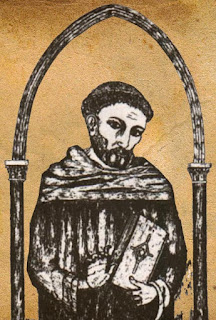Friar's records provided important information on history of Italy
 |
| Fra Salimbene travelled across Italy and beyond in a nomadic career |
Sometimes also referred to as Salimbene di Parma, he was the son of Guido di Adam, a wealthy Parma citizen. Salimbene entered the Franciscan Order in 1238 and served his novitiate in the Monastery of Fano on the Adriatic coast.
As Fra Salimbene, he led a wandering existence and never held any office in his order. He transferred from one monastery to another, meeting notable people and becoming an eye witness to historic events.
In the 1240s he travelled to Lucca, Pisa and Cremona, and also visited France.
On his return to Italy in 1248 he went to Ferrarra where he stayed for several years. But he then went on his travels again, staying in Franciscan convents in northern Italy.
Fra Salimbene began to write his Chronicles (Cronica) in 1282 and continued to work on them until his death.
| A plaque marks the house in Parma where Salimbene lived as a young man |
Salimbene described his travels, experiences and meetings with famous people, who included Frederick II, Holy Roman Emperor, Louis IX of France and Pope Innocent IV.
He provides a vivid picture of the ordinary life of his time but he also wrote about contemporary Italian politics and spirituality.
In about 1248 he wrote The Twelve Calamities of Emperor Frederick II, but other historical and religious works by him have been sadly lost.
Salimbene is believed to have died in about 1290 at a friary near San Polo d’Enza in Emilia-Romagna.
 |
| The Teatro Regio in Parma is one of Italy's most prestigious opera houses |
Parma, where Salimbene was born, is an historic city in the Emilia-Romagna region, famous for its Prosciutto di Parma ham and Parmigiano Reggiano cheese, the true ‘parmesan’. In 1545 the city was given as a duchy to the illegitimate son of Pope Paul III, whose descendants ruled Parma till 1731. The composer, Verdi, was born near Parma at Bussetto and the city has a prestigious opera house, the Teatro Regio.
| The beach at Fano is a popular attraction with visitors to the province of Pesaro and Urbino |
Fano, where Salimbene was a novice friar, is a town in the province of Pesaro and Urbino in the Marche region. It is a beach resort, about 12km (8 miles) southeast of Pesaro, where the Via Flaminia reaches the Adriatic Sea. It is the third largest town in the province after Ancona and Pesaro.
More reading:
The moment that inspired historian Edward Gibbon
Giorgio Vasari - the first historian of Italian art
The historian whose tongue-in-cheek book became a bestseller
Also on this day:
1562: The death of anatomist Gabriele Falloppio
1963: The Vajont Dam disaster
Home


